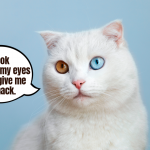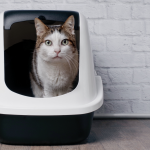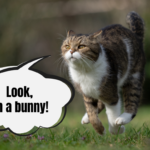To earn a cat’s trust is quite the achievement, but to get headbutted in the leg? This type of familiarity is reserved only for a selected few so if your cat does headbutt you, enjoy it, fabCat! Cats, with the exception of some very sociable individuals, usually approach strangers with caution and are not keen on getting too close and personal. When they do finally get to the stage of rubbing against you with their head and headbutting you, know you have a special place in their heart. Where did this strange way of showing trust and affection come from? Find out with us, fabCat!
What’s headbutting all about?
Headbutting (or head bunting) is a cat-specific behavior – an act of a cat rubbing their head against different objects in their vicinity, including the hooman. Though some cats put a lot of strength and intention into it, headbutting is not an act of aggression – it’s actually one of the biggest tells that a cat trusts you, feels safe with you, and wants to tell you “Hey! You’re now part of my tribe”.
Cats can “headbutt” their Carers whom they want attention from, other cats they want to say hi to (only if they already trust each other), and even objects around the house to mark them with their scent. Headbutting is one of the ways cats use to mark their territory – the cat’s face is covered with scent glands which allow cats to leave pheromones anywhere they feel safe, want to mark their presence, and establish their place on Earth. If cats headbutt each other, they mix their scents together to create one, common scent for their family.
Why do cats headbutt?
Although headbutting has a few different functions within feline communication, today we’re focusing on its role in cat-Human relations. The classic “headbutt” can be used by cats in all sorts of situations, but usually it means one of the following:
- a warm welcome. Cats feel good in their own company, but if we observed how they behave once their Carer comes back home, it would be easy to see they can actually miss their Hooman. Headbutting is one of the ways for cats to show us they’ve missed us and to welcome us home. What the cat is doing is telling us that they’re happy to see us and hope we can give them plenty of attention now. Being headbutted just as we cross the doorway is also a cat’s trick to put their scent back on us since we lost it while we were out.
- complete trust. As we mentioned before, it’s not easy to earn cat’s trust. When a cat is rubbing their head against us, the message they are sending is clear: I trust, hooman, that you won’t hurt me, I feel safe by your side and I don’t need to stay alert when I’m with you. Cats who are more sociable can headbutt people when they first meet them, showing that their intentions are friendly and they would love to get to know the hooman better.
- time for pleasure. Are all cats cuddly? Of course not! While some will try to sit in your lap immediately, others will definitely try to keep their distance and only initiate a closer bonding experience when they miss you. Headbutting is one of the signals they use – if a cat starts to rub against you with their head and nose, put your hand forward and let them show you where they want you to pet them.
How to react to headbutting?
Good question! If we try to stand over the cat and headbutt them back, there’s a big chance they’ll get scared – we’re much bigger than cats, so their instinct is to run. However, with just a small modification of your stance, you can show your furs that you trust them just as much as they trust you.
Get to your cat’s level. Kneel on the ground and let your head be on your cat’s body level or initiate a headbutt when you’re cat is higher up, on a shelf or a desk. By doing so you’re showing your cat that you are equal and when the cat rubs against you with their head first, you can easily do the same and gently place your head on their body.
Give paw. Or your hand, actually, but in a way that reminds your cat of another cat’s head. Start by pointing your index finger and letting your cat touch it with their nose, and then let your hand hang loose so your cat can rub against it. It’s a great bonding experience.
Positive reinforcement. Your cat doesn’t headbutt? No worries – some furs simply prefer other ways of communicating with hoomans. But if you do want to check if your cat trusts you, follow the steps above and … have snacks at hand. There’s no better way to positively reinforce a cat’s behavior than with some tasty treats. If your cat starts to associate you with food, you’re on a good path to friendship.
How do cats show love for their Carers?
And what to do if your cat isn’t interested in headbutting at all? No worries, it doesn’t have to be a sign of a lack of trust. Every cat is different and every cat-Carer relationship relies on a different communication style that makes both sides happy with it. We touched on it before, but there are cats who will headbutt strangers and it’s completely normal for them, and there are others who will not do it even to their beloved Carer. That’s just how it is.
If your cat:
- meows at you anytime you come back home,
- rubs on your clothes or falls asleep on them,
- kneads on you when you’re watching TV or relaxing,
- is happy to fall asleep on your lap,
- chews on your hair or plays hairdresser,
- follows you like a little shadow,
- slowly blinks at you whenever they catch you looking their way,
or rolls onto their back to show your their belly, you have nothing to worry about. Your cat loves you, trusts you, and headbutting is just not their thing.
And now a question for the audience: how do your cats, dear fabCats, show you they love you? Let’s discuss this. And if you’ve read it all up to this point, go to our Facebook profile and leave a comment under today’s post with a secret word for today: I’m headbutting!




